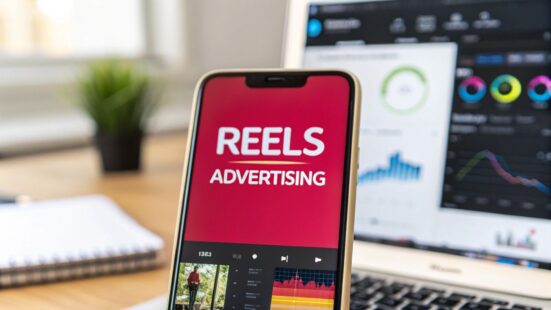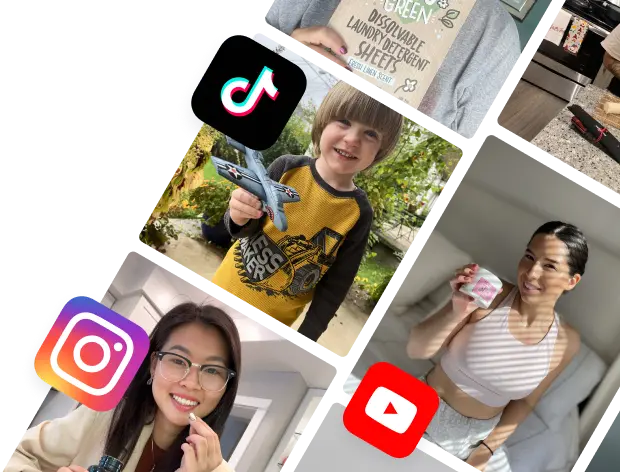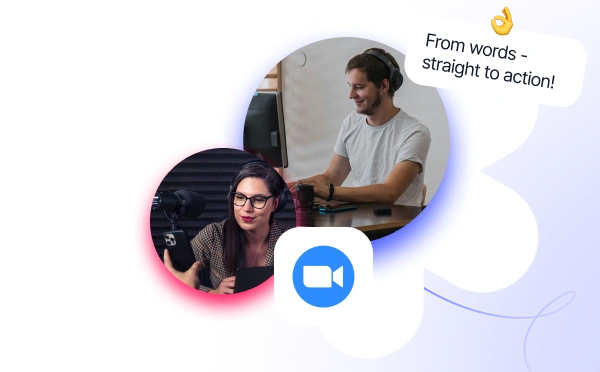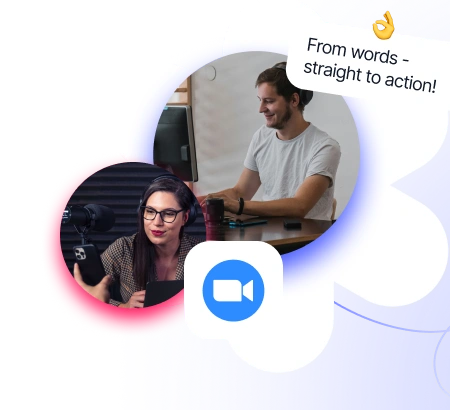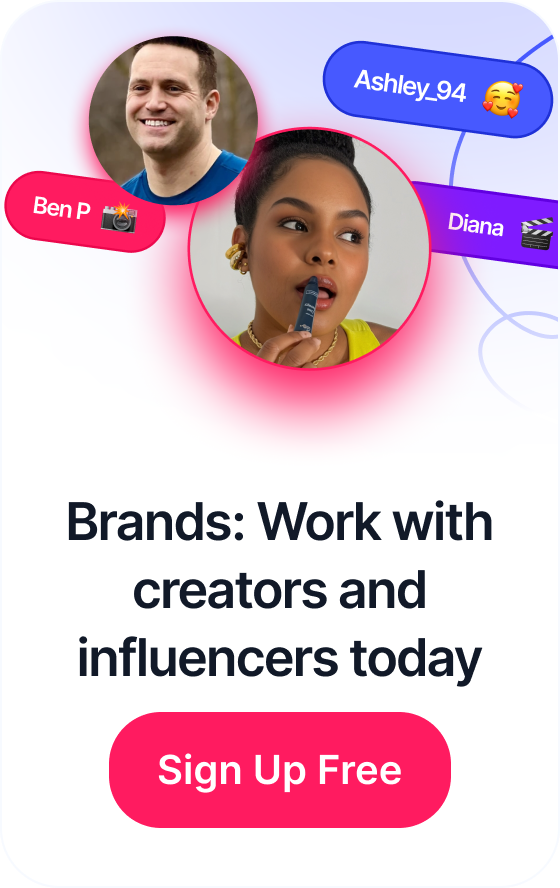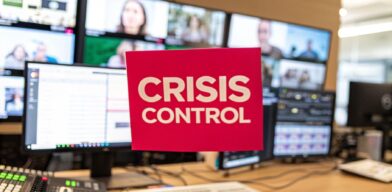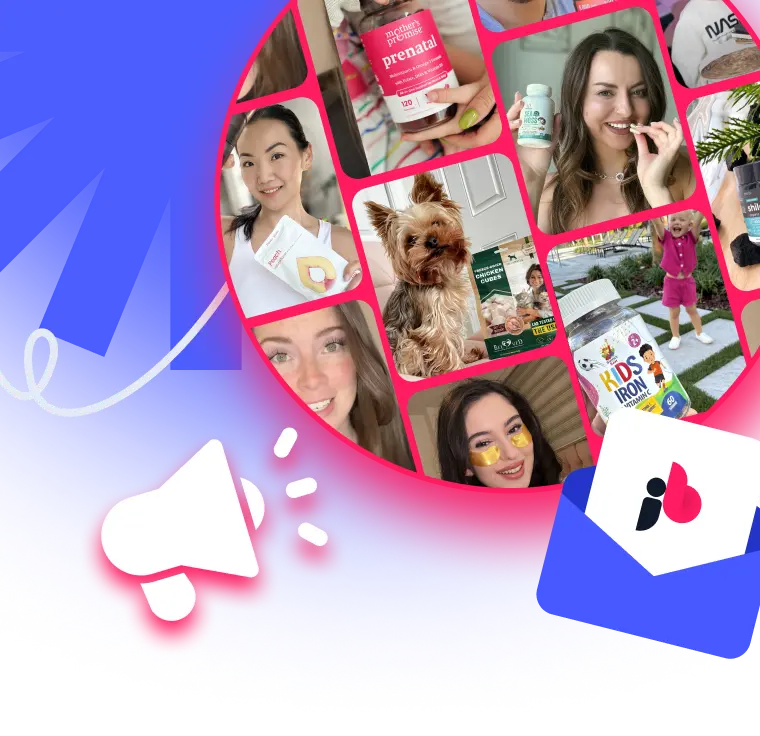 The 12 Best Influencer Marketing Software Platforms for 2025
The 12 Best Influencer Marketing Software Platforms for 2025
In simple terms, Instagram Reels advertising means you're paying to get your short-form videos in front of a specific audience. These ads pop up right in the Reels feed, Stories, and the Explore page. The goal is for them to feel like any other Reel, blending in while still hitting your targets—whether that's more website traffic, brand buzz, or actual sales.
Table of Contents
Why You Can't Afford to Ignore Reels Ads
Let's cut to the chase: Instagram is all about video now, and Reels are the main event. If you're still banking on static image posts to grow your brand, you're already behind. A winning ad strategy today means diving headfirst into the fast-paced, high-energy world of short-form video. Reels are the engine for discovery and connection on the platform.
This isn't just a fleeting trend; it’s a massive shift in how people use the app. They scroll through Reels for a laugh, to learn something new, and, crucially, to find products. This creates a huge opening for brands to connect with people in a way that feels genuine and exciting. Sidestep this format, and you’re actively ignoring a gigantic, highly engaged audience that’s hungry for new content.
Tap Into a Seriously Massive Global Audience
The sheer scale of Instagram Reels advertising is hard to wrap your head around. You have the potential to reach an estimated 726.8 million people. That's not a typo. This audience makes up about 55.1% of Instagram’s total ad reach, which just goes to show how much ground you can cover by mastering this format. You can discover more insights on Reels' extensive reach and see how it can really move the needle for your brand.
What's even better is that the algorithm is built to push great Reels to people who don't even follow you yet. Your standard feed posts mostly serve your existing audience. A killer Reels ad, on the other hand, has the potential to go viral, putting your brand in front of thousands—or even millions—of new faces.
Key Takeaway: Reels have a unique one-two punch. They keep your current community engaged while aggressively finding new audiences for you. This makes them one of the most powerful tools you have for scalable growth.
Drive Real Business Results—Not Just Views
Getting a ton of views feels great, but the real power of Instagram Reels advertising is its ability to deliver tangible results for your business. When you pair awesome creative with smart targeting, you can start hitting specific goals:
- Generate Qualified Leads: Point users directly to a lead magnet or sign-up form with a clear call-to-action.
- Increase E-commerce Sales: Tag your products right in the Reels ad. People can shop without ever leaving the app, making the path to purchase incredibly smooth.
- Boost Brand Awareness: Create content that's memorable and shareable. It’s the perfect way to introduce your brand's personality to a whole new crowd.
Building Your Campaign Foundation
Let’s be honest: a viral Instagram Reels ad almost never happens by accident. The ones that genuinely connect with an audience and actually drive results are built on a solid strategic foundation, long before anyone hits "record."
Jumping straight into creative without this groundwork is like trying to build a house without a blueprint. It gets messy, wastes money, and pretty much guarantees you won’t get the results you're after. This is where you turn your big-picture business goals into a clear, actionable game plan for your Reels campaign. It's all about defining what a "win" looks like for this specific ad.
This whole process is about moving a potential customer along a journey. This visual breaks down how a well-planned Reel can lead to real, tangible growth—from that first moment of discovery to a meaningful interaction and, finally, to a result you can actually measure.

As you can see, growth isn’t just about racking up views. It’s a deliberate process designed to guide people through an experience with your brand.
Define Your Campaign Objective First
Before you even think about trending audio or clever video hooks, you have to answer one simple question: What do I want this ad to do? A fuzzy goal like "get more engagement" is a recipe for failure. Your objective is the north star that guides every other decision you make, from the creative concept to the call-to-action button.
You have to get specific. Are you trying to:
- Drive Brand Awareness? This is a top-of-funnel play. Your main metrics are reach and impressions. The goal is simply to get your brand in front of as many new, relevant eyeballs as possible.
- Generate Qualified Leads? Here, the focus shifts to collecting contact info. Your ad needs to funnel users to a landing page with a compelling offer—think a webinar sign-up, a free guide, or a waitlist.
- Boost E-commerce Sales? This is all about direct response. The ad needs to showcase a product clearly and make it ridiculously easy for someone to tap "Shop Now" and check out.
A campaign built for brand awareness will look and feel totally different from one designed to drive immediate sales. The first might be a funny, relatable Reel that barely feels like an ad. The second is more likely a direct product demo with a clear, urgent offer.
Know Who You Are Talking To
Once you know your "what," it's time to lock down your "who." One of the biggest mistakes I see brands make is going too broad with their audience. It's a surefire way to burn through your budget. You need to go way beyond basic demographics and paint a detailed picture of your ideal customer.
Get into their heads. Think about their psychographics:
- What are the actual pain points your product solves for them?
- What kind of Reels are they already watching and sharing?
- What's their sense of humor like? What cultural trends do they get?
- What kind of slang and language do they use in their own comments and captions?
This deep understanding is what allows you to create content that feels like it was made just for them. It’s the difference between an ad they scroll past and one that gets a comment like, "Wow, this is so me." This insight is also pure gold when you start building custom and lookalike audiences in Ads Manager. If this is new territory, our guide on what is retargeting in advertising is a great place to start learning how to reconnect with users who’ve already shown interest.
Craft a Bulletproof Creative Brief
Your creative brief is the single source of truth for your campaign. Seriously. This is the document that gets your entire team—whether it’s your in-house video editor or a UGC creator you’ve just hired—on the exact same page. It’s your insurance against misunderstandings and ensures the final product is what you actually wanted.
A great brief for an Instagram Reels ad isn't a 10-page report. It's a concise, direct guide. It should be scannable but thorough.
Here’s what your brief absolutely must include:
- Campaign Objective: The single, measurable goal we defined earlier.
- Target Audience Persona: A quick but detailed summary of who you're talking to.
- Key Message: The one thing you want the viewer to walk away remembering.
- Call-to-Action (CTA): What, exactly, do you want them to do? (e.g., "Shop Now," "Learn More," "Sign Up").
- Brand Voice & Tone: Are you witty, authoritative, empathetic, or playful?
- Mandatory Inclusions: Any logos, branding elements, or legal disclaimers that have to be in the video.
- Technical Specs: Video length, 9:16 aspect ratio, and any guidelines for text overlays.
With this foundation firmly in place, you’re no longer just "making an ad." You're engineering a strategic piece of marketing designed to hit a specific business goal.
Creating Reels Ads That Actually Convert
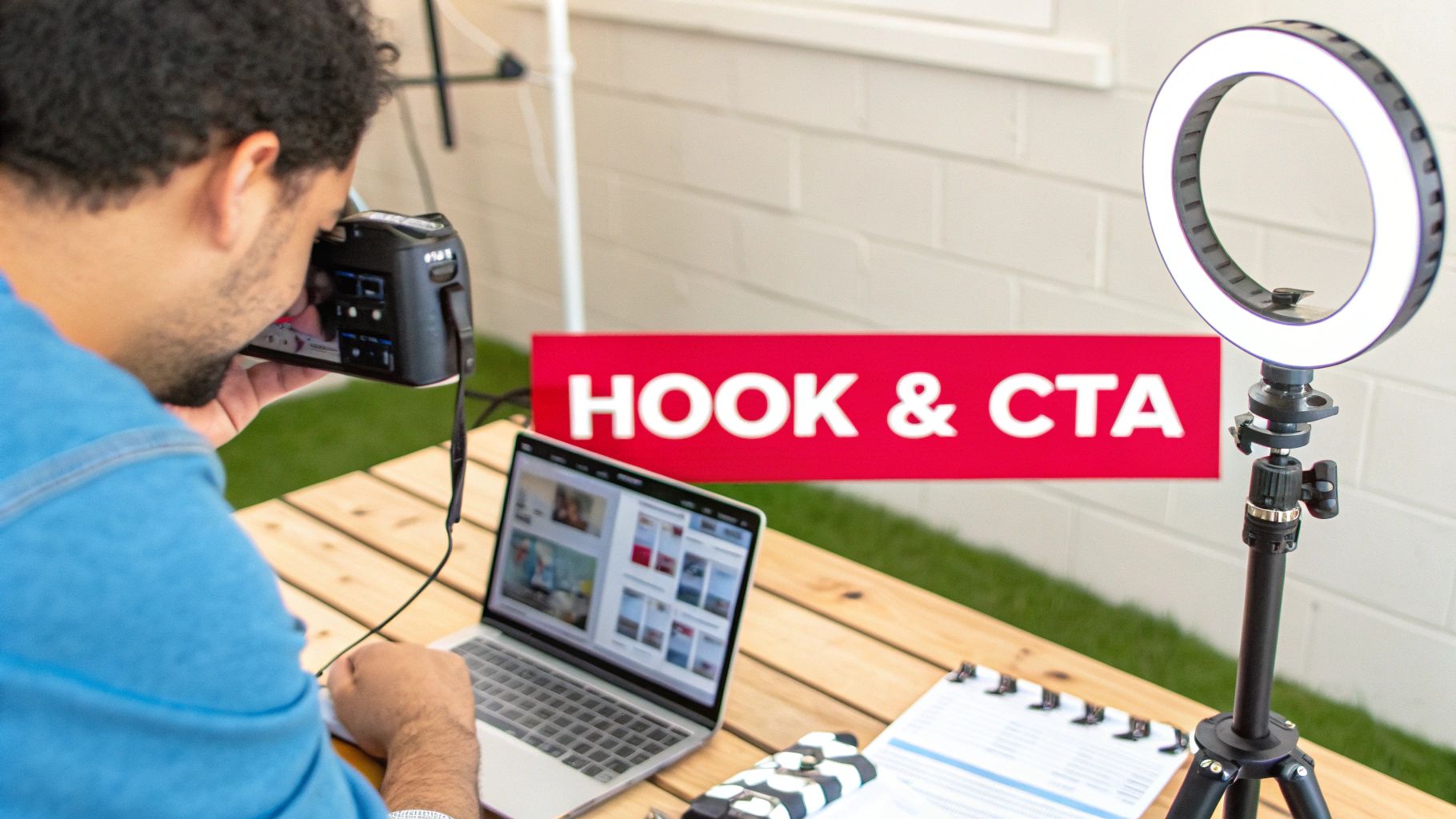
Let’s be honest. In the blink-and-you’ll-miss-it world of Instagram Reels, your creative isn't just part of the ad—it's everything. Users have a hair-trigger scroll reflex, and anything that screams "AD!" gets skipped instantly.
The real secret to winning with Instagram Reels advertising is to make ads that don't feel like ads. Your content needs to blend right into a user’s feed, matching the raw, authentic energy they came for. Nail this, and you stop being an interruption and start being part of their discovery. That’s when the scrolling stops.
Polished In-House Production vs Authentic UGC
When it comes to actually making your ads, you’ve got two main paths: shooting it yourself with an in-house team or tapping into the power of User-Generated Content (UGC) from creators. There’s no single "right" answer here; the best choice really boils down to your brand, your budget, and what you’re trying to achieve.
In-house production puts you in the driver's seat. You get total control over every single frame, from the lighting and color grading to the exact script. This is perfect for sleek product showcases or big brand statements that need that polished, professional look. The downside? It can get expensive and time-consuming, and you run a much higher risk of creating something that looks too corporate for the Reels feed.
On the flip side, User-Generated Content (UGC) is all about authenticity. When a real creator features your product, it lands like a genuine recommendation from a friend, not a sales pitch from a faceless company. This raw, relatable style builds instant trust. It's usually faster and more budget-friendly, too, since you can work with several creators at once to get a whole library of ad creative to test.
Pro Tip: Don't box yourself into an either/or mindset. The smartest ad strategies often use a mix of both. Use your slick, in-house videos for grabbing attention at the top of the funnel, and then deploy authentic UGC for mid- and bottom-funnel ads where building trust is the name of the game.
The Anatomy of a High-Converting Reel
A killer Reels ad doesn't happen by accident. It's a carefully crafted piece of content designed to get someone to do something. While there's plenty of room for creativity, the ads that consistently crush it almost always follow a similar blueprint.
Let's break down the DNA of a winning ad:
- The Hook (First 3 Seconds): You've got less than three seconds to stop the scroll. Your opening needs to be visually shocking, ask a burning question, or hit on a super relatable problem right away. Forget the slow logo reveal—jump straight into the action.
- The Core Message (Seconds 4-10): You've got their attention. Now, what's in it for them? This is where you quickly show how your product solves their problem or show off its most "wow" feature. Keep it tight, punchy, and focused on the benefit.
- The Build-Up (Seconds 11-15): Now you need to seal the deal. This is the spot for social proof, a quick testimonial, or a rapid-fire showcase of different ways to use the product. Fast cuts and engaging visuals keep the energy high and build credibility.
- The Call-to-Action (CTA): Tell people exactly what to do next. "Shop Now," "Learn More," or "Sign Up" should be reinforced with on-screen text and maybe even a voiceover right before the ad ends. This gets them ready to click that button.
Essential Creative Elements to Include
Getting the structure right is half the battle. The other half is layering in the small details that make your ad feel native to the Reels platform.
We've found a few key ingredients are non-negotiable for top performance. Here’s a quick-glance table to keep handy.
Key Creative Elements for High-Performing Reels Ads
| Creative Element | Best Practice & Why It Works |
|---|---|
| On-Screen Text Overlays | Use bold, easy-to-read text to highlight your main points. Many people watch with the sound off, so text ensures your message always lands. |
| Trending Audio | Tapping into a popular sound from Instagram's Sound Collection helps your ad feel organic and current. The algorithm often favors it, giving you a free boost. |
| Authentic Visuals | Ditch the glossy stock footage. Shoot vertically (9:16) and aim for a "shot-on-a-phone" vibe, even if it's not. Relatability almost always beats high production value. |
| Clear & Simple CTA | Stick to one, crystal-clear action. Overloading the viewer with choices leads to them choosing nothing. Your final shot should be visually tied to the action you want them to take. |
Sprinkling these elements into your ads will make a massive difference.
And the data backs this up. The average engagement rate for Instagram Reels is a hefty 1.23%. A typical Reel pulls in around 243 likes, 8 comments, and 28 saves, showing just how much potential there is when your creative hits the mark.
If you need some inspiration to get the ball rolling, check out our guide packed with Instagram Reel ideas for businesses. By combining a solid structure with these native elements, you’ll be well on your way to making Reels ads that don't just get views—they get results.
Right, you've got your creative assets polished and your strategy mapped out. Now it's time to step into the control room: Meta Ads Manager. This is where your plan actually comes to life. The interface can look a little intimidating at first, but launching a killer Reels campaign really just boils down to getting a few key decisions right from the start.
Think of Ads Manager as the engine. Every setting you dial in—from your objective to your audience—is a direct instruction to Instagram’s algorithm. You're telling it exactly who you want to see your ad and what you want them to do next.
Choosing the Right Campaign Objective
The very first choice you'll make is your campaign objective, and honestly, it’s the most important one. This single click tells Meta what a "win" looks like for your campaign, which completely dictates who sees your ad and how your budget is spent.
Pick Traffic, and the algorithm will go find people who love to click links. Select Sales, and it will hunt down users with a history of buying things. Getting this wrong is like punching the wrong address into your GPS—you'll burn through your budget going in a completely different direction.
Here’s a practical look at the most common objectives for Reels ads:
- Awareness: This is your go-to for getting your brand in front of as many new eyeballs as possible. Meta will optimize for reach and impressions. It's perfect when you're launching a new product or breaking into a new market.
- Traffic: Use this when you want to send people to a specific place, like a blog post or a landing page. The main goal here is the click itself, not necessarily what they do once they get there.
- Engagement: A fantastic choice for putting some firepower behind an existing Reel. The algorithm will show your ad to people most likely to like, comment, and share, building up that all-important social proof.
- Leads: If you need to collect contact information, this is your objective. It’s designed to find users who are likely to fill out a form for a newsletter, a webinar, or a free guide.
- Sales: The bread and butter for e-commerce. Meta’s algorithm will laser-focus on finding users who are most likely to convert, optimizing for actions like Add to Cart or Purchase.
To really nail this part, it helps to have a solid foundation in mastering Instagram ad campaigns effectively. That wider knowledge ensures every decision you make is the right one.
Mastering Audience Targeting
Objective locked in? Great. Now, let's decide who sees your ad. This is where you can get seriously strategic and move way beyond basic demographics. Your two most powerful tools here are Custom Audiences and Lookalike Audiences.
Custom Audiences are your warm leads—people who already know you. You can build these lists from a few different places:
- Customer List: Got a list of emails or phone numbers? Upload it. Meta will match them to Instagram profiles so you can re-engage past customers or leads.
- Website Visitors: If you have the Meta Pixel installed, you can target anyone who's been on your site. Better yet, get specific: target people who viewed a certain product or, even better, abandoned their cart.
- Instagram Account: This lets you create an audience of people who've already interacted with your profile—they’ve watched your videos, liked a post, or sent you a DM.
Key Insight: Don't just target "all website visitors." Create a hyper-targeted Custom Audience of users who added a product to their cart in the last 14 days but didn't buy. That group is practically begging for a retargeting Reel to remind them what they're missing.
Once you have a solid Custom Audience, you can create a Lookalike Audience. This is where the magic happens. You feed Meta a source audience (like your top-spending customers), and its algorithm goes to work analyzing their shared traits to find millions of new people who "look like" them. It's an incredibly powerful way to find new customers.
Selecting Ad Placements and Using Existing Posts
Next up, you'll choose where your ads show up. By default, Meta will push you towards Advantage+ placements. This gives the algorithm free rein to show your ad across its entire network, including Facebook, Messenger, and beyond.
While that can be effective, for a dedicated Reels campaign, you'll probably want more control. Switch over to Manual Placements and select only Instagram Reels. This guarantees your 9:16 vertical video appears exactly where it's supposed to, which almost always results in better performance and a smoother user experience.
Finally, under the Ad setup, you have one more crucial decision. You can create a new ad from scratch or use an existing post. The Use Existing Post option is a total game-changer.
This lets you put your ad budget behind an organic Reel that's already doing well on your profile. This approach, often called a Spark Ad, leverages all the social proof that post has already earned. When someone sees an ad with hundreds of likes and glowing comments, it feels less like an ad and more like a piece of popular content. That credibility boost can do wonders for your conversion rates.
How to Measure and Optimize Performance
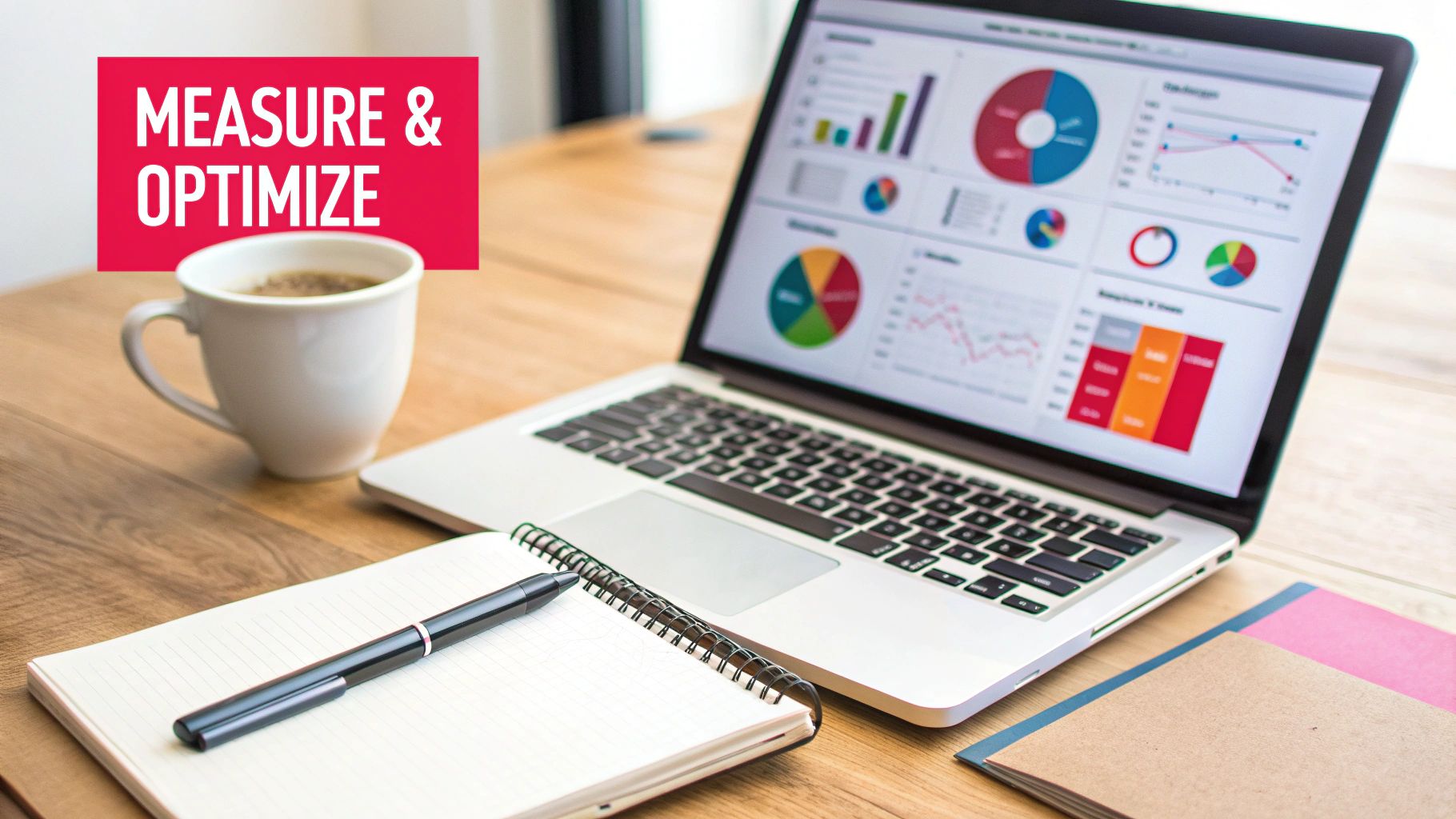
Hitting "Publish" on your Reels ad campaign feels great, but it's just the starting line. The real work—and the real results—come from what you do next. This is where you graduate from just another advertiser into a sharp, data-driven strategist.
You'll be diving deep into Meta Ads Manager, turning raw numbers into smart decisions. The goal isn't just to see how your ad did; it's to understand why it performed that way and figure out what tweaks will make the next one even better. This cycle of continuous improvement is what separates campaigns that fizzle out from those that deliver a serious return on your investment.
Focusing on the KPIs That Actually Matter
When you open Ads Manager, it's easy to feel overwhelmed by the sheer volume of data. It's also tempting to get lost in vanity metrics like likes and shares. While those are nice ego boosts, they don't tell you if your Instagram Reels advertising is actually growing your business.
To cut through the noise, you need to zero in on the Key Performance Indicators (KPIs) that connect directly to your original campaign objective. These are the metrics that tell the true story of your success.
To give you a clearer picture, here's a breakdown of the metrics I live by when running Reels ad campaigns.
Essential KPIs for Reels Ad Optimization
These are the core metrics you'll want to add to your Ads Manager dashboard. They provide a complete view of your campaign's health, from creative engagement to bottom-line profitability.
| Metric (KPI) | What It Measures | What a Good Result Looks Like |
|---|---|---|
| Return On Ad Spend (ROAS) | The total revenue generated for every dollar spent on ads. Your ultimate profitability metric. | 2x is often the breakeven point, but you should aim for 3x or higher for strong profitability. |
| Cost Per Result (CPR) | How much you pay for a specific action (e.g., purchase, lead, add to cart). | This is highly dependent on your industry and product price, but the goal is to drive it as low as possible. |
| View-Through Rate (VTR) | The percentage of viewers who watched your entire Reel ad. A direct measure of creative engagement. | Anything above 15-20% is a strong indicator that your creative is captivating and holding attention. |
| Click-Through Rate (CTR) | The percentage of viewers who saw your ad and clicked on your call-to-action link. | A healthy CTR for Reels is typically 1% or higher. A low CTR can signal a weak CTA or a mismatch between the ad and the offer. |
By keeping a close eye on these specific numbers, you can diagnose problems and spot opportunities with much greater accuracy.
For an even more detailed look at what these numbers mean in a broader context, our guide on measuring marketing campaign effectiveness provides a great framework. Understanding these core metrics is the first step toward true optimization.
Key Takeaway: Don't get distracted by surface-level engagement. If your goal is sales, ROAS and Cost-Per-Result are your most important KPIs. If your goal is awareness, focus on Reach and View-Through Rate. Always match your metrics to your mission.
A Simple Framework for A/B Testing
You should never, ever assume you know what will work best. The only way to find out what truly resonates with your audience is to test, test, and test again. A/B testing, or split testing, is simply the process of running two slightly different versions of an ad to see which one performs better.
The golden rule of effective A/B testing is to change only one variable at a time. If you change the headline, the video, and the audience all at once, you’ll have no idea which change was responsible for the results.
Here’s a practical list of what you should be testing:
- Creative: Pit two completely different video concepts against each other. For example, test a polished, in-house video against a raw, authentic UGC-style Reel.
- Hooks: Use the exact same video but change only the first three seconds. A different opening line or a surprising visual can have a massive impact on your VTR.
- Headlines: The primary text that accompanies your ad really matters. Test a question-based headline against one that highlights a key benefit.
- Audiences: Run the same winning ad creative to two different audiences. For instance, test a Lookalike Audience based on your top customers against a broad, interest-based audience.
By methodically testing these elements, you'll gather concrete data on what your audience responds to, allowing you to build more effective ads over time.
Knowing When to Scale and When to Kill
Smart budget management is what separates profitable advertisers from those who just burn cash. Your data will tell you exactly what to do with your money.
First, a crucial tip: let your ads run for at least 48-72 hours before making any drastic decisions. This gives Meta's algorithm enough time to exit the "learning phase" and gather stable performance data.
From there, the rules are pretty simple:
- Scale the Winners: If an ad set is hitting your target CPR or ROAS, it's a winner. Start increasing its budget gradually—by about 20-30% every few days—to scale up without shocking the algorithm and resetting the learning phase.
- Kill the Losers: If an ad set is performing well below your targets after that initial learning period, don't be afraid to pause it. There's no room for emotion here. Funnel that budget into your winning ads or into new tests.
This disciplined approach ensures you're constantly putting your money behind what works, maximizing your overall campaign efficiency. For a deeper dive into the broader context, this practical guide on how to measure social media engagement offers valuable insights that apply beyond just paid ads.
Got Questions About Reels Ads? We’ve Got Answers.
Even with the best playbook in hand, you’re bound to hit a few snags or have questions pop up once you're actually running an Instagram Reels advertising campaign. It happens to everyone. Let's tackle some of the most common questions we hear from brands in the trenches.
What Is the Ideal Length for a Reels Ad?
While organic Reels can stretch to 90 seconds, you don't have that luxury with ads. The sweet spot is almost always between 15 and 30 seconds.
Honestly, the most important part isn't the total length—it's what happens in the first three seconds. You have to snag their attention immediately before their thumb decides to keep scrolling. Focus on getting your main point across quickly and in a way that feels native to the Reels feed. You can always test different lengths, but a killer hook beats a longer video every single time.
How Much Should I Spend on Reels Advertising?
This is the million-dollar question, but there's no magic number. Your budget really depends on your industry, what you're trying to achieve, and who you're targeting.
For brands just dipping their toes in, starting with $10 to $20 per day for an ad set is a solid benchmark. It’s enough to get the data you need to see what’s actually working without betting the farm.
Once you find that winning combo of creative and audience, you can start scaling up. A good rule of thumb is to bump your budget by 20-30% every few days. This lets you grow without shocking the algorithm and resetting its learning phase.
Our take: It’s way smarter to start small, prove your concept with real data, and then scale with confidence. A small, focused budget that delivers results is infinitely better than a huge one wasted on ads that don't connect.
Should I Use Trending Audio in My Ads?
Absolutely… with a big caveat. Using trending audio can make your ad feel way more organic and can definitely help with reach, since the algorithm loves popular sounds. But—and this is a big but—you must have the commercial license to use that music in a paid ad.
The safest bet? Stick to Instagram's Sound Collection inside Ads Manager. It's a whole library of royalty-free music and sounds that are already cleared for commercial use. Don't risk the legal headache just to jump on a trend with unlicensed audio. It's never worth it.
Boosting a Reel vs. Creating a New Ad—What's the Difference?
This one trips people up all the time. When you create a new ad in Ads Manager, it's built from the ground up and only ever exists as a paid promotion.
Boosting, on the other hand, is when you take an organic Reel that's already live on your profile and put ad money behind it. This is often called a Spark Ad.
The huge advantage of boosting is that you're amplifying a post that already has social proof. All those organic likes, comments, and shares come along for the ride. This makes the ad feel less like an ad and more like a genuinely popular piece of content, which can do wonders for your credibility and engagement rates.
Ready to stop guessing and start connecting with authentic creators for your next Reels campaign? JoinBrands provides the tools and talent pool to produce high-performing UGC that converts. Find the perfect creator for your brand today!
